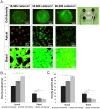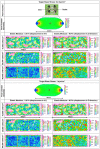Mapping the mechanome of live stem cells using a novel method to measure local strain fields in situ at the fluid-cell interface
- PMID: 22970134
- PMCID: PMC3438189
- DOI: 10.1371/journal.pone.0043601
Mapping the mechanome of live stem cells using a novel method to measure local strain fields in situ at the fluid-cell interface
Abstract
During mesenchymal condensation, the initial step of skeletogenesis, transduction of minute mechanical forces to the nucleus is associated with up or down-regulation of genes, ultimately resulting in formation of the skeletal template and appropriate cell lineage commitment. The summation of these biophysical cues affects the cell's shape and fate. Here, we predict and measure surface strain, in live stem cells, in response to controlled delivery of stresses, providing a platform to direct short-term structure--function relationships and long-term fate decisions. We measure local strains on stem cell surfaces using fluorescent microbeads coated with Concanavalin A. During delivery of controlled mechanical stresses, 4-Dimensional (x,y,z,t) displacements of the bound beads are measured as surface strains using confocal microscopy and image reconstruction. Similarly, micro-particle image velocimetry (μ-piv) is used to track flow fields with fluorescent microspheres. The measured flow velocity gradient is used to calculate stress imparted by fluid drag at the surface of the cell. We compare strain measured on cell surfaces with those predicted computationally using parametric estimates of the cell's elastic and shear modulus. Finally, cross-correlating stress--strain data to measures of gene transcription marking lineage commitment enables us to create stress--strain--fate maps, for live stem cells in situ. The studies show significant correlations between live stem cell stress--strain relationships and lineage commitment. The method presented here provides a novel means to probe the live stem cell's mechanome, enabling mechanistic studies of the role of mechanics in lineage commitment as it unfolds.
Conflict of interest statement
Figures







Similar articles
-
In situ spatiotemporal mapping of flow fields around seeded stem cells at the subcellular length scale.PLoS One. 2010 Sep 17;5(9):e12796. doi: 10.1371/journal.pone.0012796. PLoS One. 2010. PMID: 20862249 Free PMC article.
-
Mechanical modulation of nascent stem cell lineage commitment in tissue engineering scaffolds.Biomaterials. 2013 Jul;34(23):5766-75. doi: 10.1016/j.biomaterials.2013.04.023. Epub 2013 May 7. Biomaterials. 2013. PMID: 23660249 Free PMC article.
-
Modulation of stem cell shape and fate B: mechanical modulation of cell shape and gene expression.Tissue Eng Part A. 2008 Sep;14(9):1573-80. doi: 10.1089/ten.tea.2008.0113. Tissue Eng Part A. 2008. PMID: 18774911
-
[Research status of mechanical stimulation of stem cells differentiation in stem cells microenvironment].Zhongguo Xiu Fu Chong Jian Wai Ke Za Zhi. 2014 Jan;28(1):100-4. Zhongguo Xiu Fu Chong Jian Wai Ke Za Zhi. 2014. PMID: 24693789 Review. Chinese.
-
Role of mechanical factors in fate decisions of stem cells.Regen Med. 2011 Mar;6(2):229-40. doi: 10.2217/rme.11.2. Regen Med. 2011. PMID: 21391856 Free PMC article. Review.
Cited by
-
Elucidating multiscale periosteal mechanobiology: a key to unlocking the smart properties and regenerative capacity of the periosteum?Tissue Eng Part B Rev. 2013 Apr;19(2):147-59. doi: 10.1089/ten.TEB.2012.0216. Epub 2013 Feb 1. Tissue Eng Part B Rev. 2013. PMID: 23189933 Free PMC article. Review.
-
Emergence of Form from Function - Mechanical Engineering Approaches to Probe the Role of Stem Cell Mechanoadaptation in Sealing Cell Fate.Bioarchitecture. 2016;6(5):85-103. doi: 10.1080/19490992.2016.1229729. Epub 2016 Oct 14. Bioarchitecture. 2016. PMID: 27739911 Free PMC article.
-
Displacement and strain mapping for osteocytes under fluid shear stress using digital holographic microscopy and digital image correlation.Biomed Opt Express. 2021 Mar 9;12(4):1922-1933. doi: 10.1364/BOE.418418. eCollection 2021 Apr 1. Biomed Opt Express. 2021. PMID: 33996207 Free PMC article.
-
The cytoskeleton and connected elements in bone cell mechano-transduction.Bone. 2021 Aug;149:115971. doi: 10.1016/j.bone.2021.115971. Epub 2021 Apr 21. Bone. 2021. PMID: 33892173 Free PMC article. Review.
-
Low intermittent flow promotes rat mesenchymal stem cell differentiation in logarithmic fluid shear device.Biomicrofluidics. 2020 Oct 27;14(5):054107. doi: 10.1063/5.0024437. eCollection 2020 Sep. Biomicrofluidics. 2020. PMID: 33163135 Free PMC article.
References
-
- Knothe Tate ML, Dolejs S, Miller RM, Knothe UR (2010) Role of mechanical loading in healing of massive bone autografts. J Orthop Res 28: 1657–1664. - PubMed
-
- Zimmerman J, Knothe Tate ML (2011) Structure - function relationships in the stem cell's mechanical world A: Seeding protocols as a means to control shape and fate in live cells. Mol Cell Biomech 8: 275–296. - PubMed
-
- Anderson EJ, Knothe Tate ML (2007) Design of tissue engineering scaffolds as delivery devices for mechanical and mechanically modulated signals. Tissue Eng 13: 2525–2538. - PubMed
Publication types
MeSH terms
Grants and funding
LinkOut - more resources
Full Text Sources
Medical
Research Materials

